In This Topic
Step 1: Check your data for problems
Important
For a more thorough analysis of these requirements, use Nonnormal Capability Sixpack.
Visually examine the distribution of the data
Compare the distribution curve to the bars of the histogram to assess whether your data seem to follow the distribution that you chose for the analysis. If the bars vary greatly from the curve, your data may not follow your chosen distribution and the capability estimates may not be reliable for your process. If you are unsure which distribution best fits your data, use Individual Distribution Identification to identify an appropriate distribution or transformation.
Also, look for bars that are located away from most of the other data. Outliers in your data may affect the accuracy of the capability analysis. They could also indicate that your process is not stable.
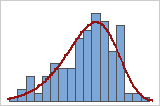
Good fit
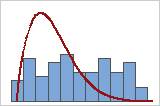
Poor fit
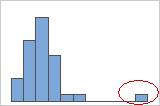
Outlier
Note
To verify that your process is stable, use a control chart.
Step 2: Examine the observed performance of your process
Use the capability histogram to examine the sample observations in relation to the process requirements.
Examine the process spread
Visually examine the data in the histogram in relation to the lower and upper specification limits. Ideally, the spread of the data is narrower than the specification spread, and all the data are inside the specification limits. Data that are outside the specification limits represent nonconforming items.
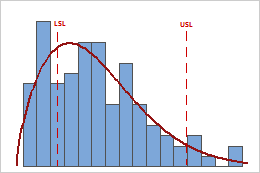
In this histogram, the process spread is wider than the specification spread, which suggests poor capability. Although most of the data are within the specification limits, many nonconforming items are below the lower specification limit (LSL) or above the upper specification limit (USL).
Note
To determine the actual number of nonconforming items in your process, use the results for PPM < LSL, PPM > USL, and PPM Total. For more information, go to All statistics and graphs.
Assess the location of the process
Evaluate whether the process is centered between the specification limits or at the target value, if you have one. The peak of the distribution curve shows where most of the data are located.
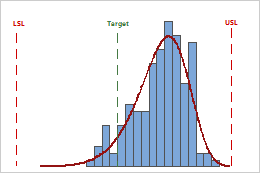
In this histogram, although the sample observations fall inside the specification limits, the peak of the distribution curve is not on the target. Most of the data exceed the target value and are located near the upper specification limit.
Step 3: Evaluate the capability of the process
Use Ppk to evaluate the overall capability of your process based on both the process location and the process spread. Overall capability indicates the actual performance of your process that your customer experiences over time.
Generally, higher Ppk values indicate a more capable process. Lower Ppk values indicate that your process may need improvement.
Compare Ppk to a benchmark value that represents the minimum value that is acceptable for your process. Many industries use a benchmark value of 1.33. If Ppk is lower than your benchmark, consider ways to improve your process.

Key Result: Ppk
For these process data, Ppk = 0.25. Because Ppk is less than 1.33, the overall capability of the process does not meet customer requirements. You should take steps to improve the process.
Important
The Ppk index represents the process capability for only the "worst" side of the process measurements, with respect to either the lower or the upper specification limit. If your process produces nonconforming items that fall outside both the lower and upper specification limits, use additional capability measures in the output to more fully assess process performance. For more information, go to All statistics and graphs.
